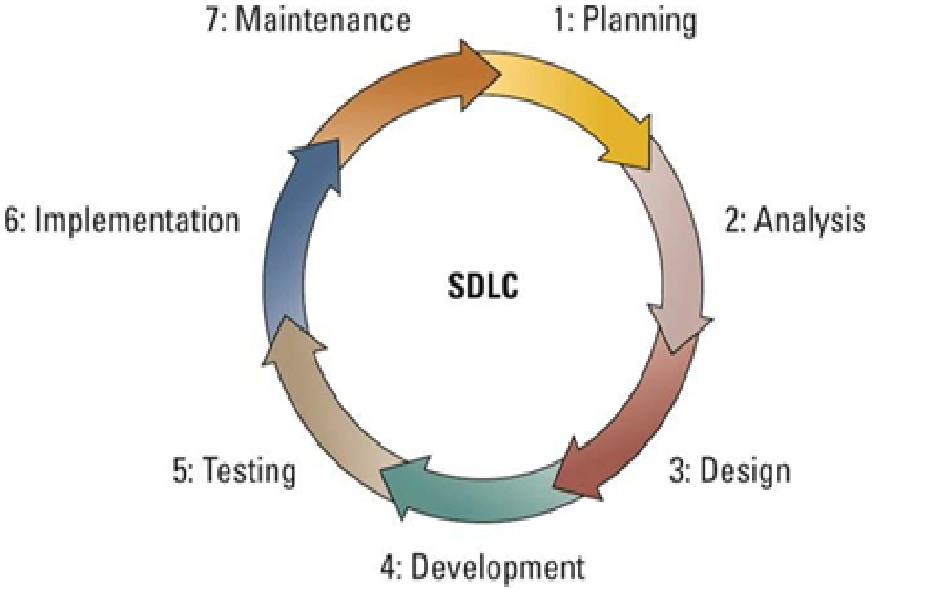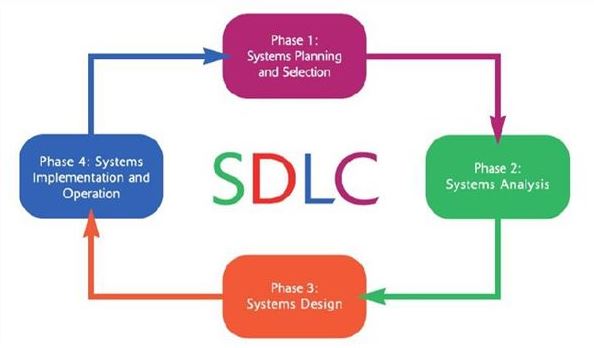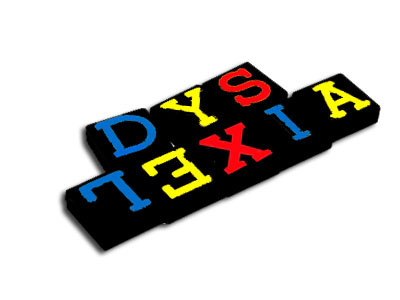System Development Life Cycle (SDLC)
Seven Step SDLC
The System Development Life Cycle (SDLC) ensures end-state solutions in accordance to the requirements provided by the user in support of business strategic goal and objectives. It represents a structured, systematic approach that aims at developing information systems. The SDLC incorporates a comprehensive checklist of rules and regulations governing IT systems. The provisions are aimed at ensuring system developers adhere to the different set guides. The seven step SDLC incorporates seven phases that need adamant consideration by the developers to ensure accurate realization of the intended goals. The phases include planning, analysis, design, development, testing, implementation, and maintenance.

First, the planning phase of the SDLC demands the developers need to determine a solid plan for developing the information system desired. In the phase, three primary activities need to be ensured for optimality. The system to be developed must be defined, identified and selected in accordance with the strategic goals of the organization (Balaji& Murugaiyan, 2012). Secondly, the developer needs to consider the scope of the project. The scope provides the high-level system requirements. It is the basic definition of the system. Lastly, the system development team needs to define the project plan. Hoffer (2012) argues that a plan responds to the what, when and who questions in the system developing activities together with all the activities to be performed including the individuals and resources to be involved in the SDLC process.
Secondly, the analysis phase, which involves the end users and IT specialists. The two stakeholders gather, understand and document business requirements for the intended system. Primarily, the developers at the stage aim at gathering sufficient information regarding the business or end user requirements (Rosenblatt, 2013). The requirements are the knowledge workers’ requests that the system must meet to be qualified as successful. This can be undertaken using a Joint Application Development (JAD) session. A process in which knowledge workers and IT specialists engage one another to define and review business requirements.
In the third phase, the design, the developers build a technical blueprint detailing how the proposed system will work. According to Rosenblatt (2013), the point of view shifts from a business perspective to a technical one. Immediately, the development phase follows. The phase takes consideration of all detailed design documents from the design phase and transform them to an actual system. The developers during the phase build the different technical architecture by purchasing and setting it up. In addition, the necessary software programs are written in the database for ease of navigation by the end user.
Once the system is developed, there is a need to test the program. This comes in handy as the fifth step in the seven step SDLC. Here the system is verified on whether it executes all the business requirements as defined in the analysis phase. A detailed test condition is developed and performed with the expected results evaluated. Once the developers are satisfied that the system works appropriately, they proceed to the implementation phase. In this step, the system is distributed to all knowledge workers who begin using the system to perform their routine jobs. However, a user documentation must be provided, which details how the knowledge workers will use the system.
The implementation phase might take different approaches depending on the end user and the developing team (Leau, Loo, Tham & Tan, 2012). Such include the pilot, phased, plunge or the parallel implementation. Each of the implementation holds merit and demerits that the stakeholders need to consider.
The seven step SDLC considers maintenance as the last phase. In the phase, stakeholders monitor and support the new system to ensure its ability to enable the business to realize its goals. During the phase, the developers and knowledge workers can advance the system with the different changes of the business environment.
Four Step SDLC Model

The four-step SDLC model considers a different number of steps to be involved in the development of a system for a business entity. The different steps include identification, design, construction and evaluation and risk analysis. Under the four step SDLC, the project goes through the four phases in iterations (Boehm, 1988). The SDLC model similar to the seven-step model begins by the identification of the objectives in relation to the business that the developers and the knowledge workers desire to execute using the system.
In the initial phase, identification, business requirements are gathered and later a system appropriate for the requirements identified. In addition, subsystem requirements and unit requirements are executed at the phase to ensure consistency during the development phase. Therefore, the knowledge workers and the developer need to interact excessively to ensure a mutual content on the needs that the system should satisfy. Significantly, the different alternatives and constraints are identified by the parties who later see a way of mitigating each of the shortcoming for the benefit of developing a perfect system.
Once the identification stage is complete, the team launches the design phase. The phase involves a conceptual design and an architectural design, logical design, physical product design and the final design. The different designs serve a greater role in ensuring systematic analysis of the project at each level of design to address any likely challenges. The construction stage comes in handy after the two phases are successfully executed. In the phase, the actual system is developed and engaged for the different needs.
A Proof of Concept document needs to accompany the system during the delivery to the knowledge workers to get feedback on the system (Boehm, Lane, Koolmanojwong & Turner, 2014). The information is often used for advancing or corrective measures necessary to ensure client satisfaction. The testing of the project is also done at the stage to optimize correction of the system.
In the last phase of the four-step SDLC process, the developer and client conduct a risk analysis procedure where they identify, estimate and monitor any technical feasibility probable. The appropriate management risks are engaged to ensure optimal results. For instance, a schedule slippage and cost overrun can be conducted to optimize the process. The customer needs to evaluate the system developed to determine whether it meets the project specifications provided during the first phase. In case the client or the developer identifies any issues concerning the system, the necessary steps are undertaken to resolve the problem. Considering the short cycle of the four-step model, reviews are inevitable in each phase (Boehm, 1988). The client and developers concerned with the system development analyze the previous cycle. The review covers all products developed in the previous cycle, including the plans for the next cycle. In addition, the required resources are evaluated for executing the subsequent cycle.
Comparing and Contrasting the Seven Step and Four Step Models
The seven-step and four-step model elicit similarities and differences worth considering in the study. The two models embrace the need to conduct preliminary analysis and ensure constant communication between the client and developer for the efficiency and effectiveness of the system. In the planning and identification phases, the need to optimize on information gathered, especially the objectives to be realized by the system is highlighted. Additionally, the design phase between the two models also elicits similarities. The two models rely on analysis, although the latter does not provide a higher prominence when compared to the seven-step model, which assumes analysis as a phase in the system development process (Boehm, Lane, Koolmanojwong & Turner, 2014).
Contrastingly, the four-step model considers the elimination of risk in the system establishment as the focus in defining the success of a system. This varies with the seven-step model that considers the adoption of the client needs into the system as the focus. As such, the four-step system ensures preliminary evaluation of risks in each phase. The review process in the four-step model is engaged at each phase. This is different to the seven-step that tends to review the project during the maintenance stage. As such, maintenance is cheaper in terms of cost and time for the four-step compared to the seven-step. The review explains why the four-step model does not have any phase identified as maintenance iterations (Boehm, 1988). In addition, the high status of the review in the different phases optimizes the ability of the developer to minimize any risk that might destabilize the organization. Thus, the system is developed in accordance with the inherent risks within the organization. Therefore, easy to customize the system to suit the needs of the organization.
References
Balaji, S., & Murugaiyan, M. S. (2012). Waterfall vs. V-Model vs. Agile: A comparative study on SDLC. International Journal of Information Technology and Business Management, 2(1), 26-30.
Boehm, B. W. (1988). A spiral model of software development and enhancement. Computer, 21(5), 61-72.
Boehm, B., Lane, J. A., Koolmanojwong, S., & Turner, R. (2014). The incremental commitment spiral model: Principles and practices for successful systems and software. Addison-Wesley Professional.
Hoffer, J. A. (2012). Modern Systems Analysis and Design, 6/e. Pearson Education India.
Leau, Y. B., Loo, W. K., Tham, W. Y., & Tan, S. F. (2012). Software development life cycle AGILE vs traditional approaches. In International Conference on Information and Network Technology (Vol. 37, No. 1, pp. 162-167).
Rosenblatt, H. J. (2013). Systems Analysis and Design. Cengage Learning.




